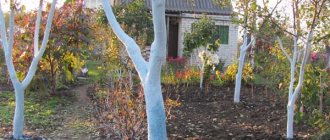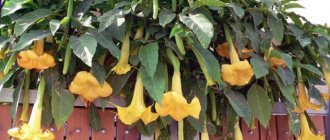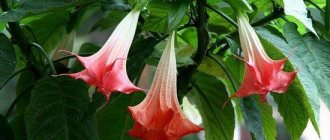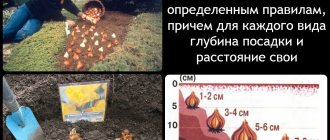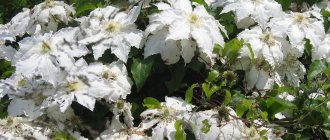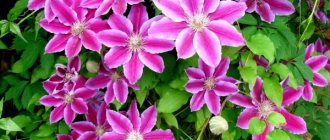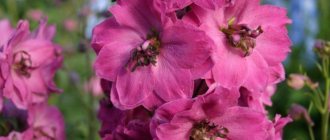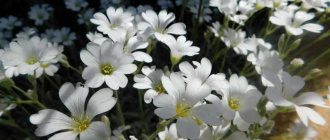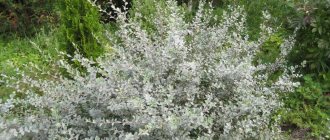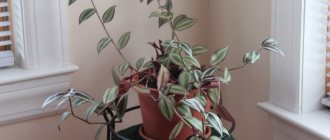Types, photos and names
In the Solanaceae family, the Brugmansia genus is represented by 7 species, including trees and shrubs .
They grow in South and Central America; some species are also found in the southern regions of North America.
Until 1973, the perennial plant was classified in the Datura genus, but then it was separated into a separate genus. It has a voluminous crown with wide branching; the leaves on the branches are arranged in tiers and are ovoid in shape. The length of one leaf plate can reach 30 cm.
The main visual appeal lies in the large flowers, which can be painted in white, yellow, red and lilac shades .
They are tubular in shape with a bell-shaped rim. The length of the flower varies from 20 to 50 cm. Brugmansia blooms magnificently and fragrantly.
The progenitor of the genus is considered to be Brugmansia arborescens. We have prepared photos and descriptions of the most popular plant species.
Bloody (Brugmansia sanguinea)
In natural conditions, the tree-like Brugmansia grows up to 14 meters, representing a luxurious tree with large leaves and flowers. The corollas have retained the bell shape, but, unlike other species, do not have petals.
This feature is due to the fact that the tree is pollinated by hummingbirds, which find it more convenient to perch on the solid curl of the corolla. The color scheme includes all shades of red with variations of yellow tones.
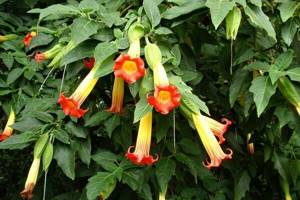
Snow White (Brugmansia candida)
Snow-white Brugmansia is a tree with a height of 5 meters and a crown diameter of 3 meters. It has ellipse-shaped leaves with jagged edges. The flowers are not very large for the genus, only 20 cm in length.
The snow-white variety is confused with datura, which has bluish flowers. The main difference is not difficult to notice: in Datura the flowers look up, while in Brugmansia they slope down.
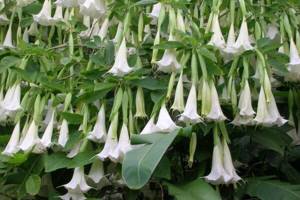
Fragrant (Brugmansia suaveolens)
The flower is characterized by fast growth and rich aroma. The length of the flowers is 30 cm, they are painted in pink and yellow tones, smoothly turning into light green and white shades.
This is a small tree with a height of 4 meters and a crown width of 3 meters. Its leaves can be oval or elliptical with a matte surface.
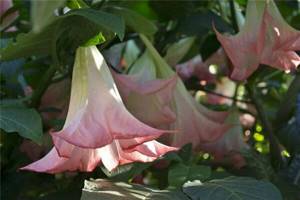
Interesting! In our gardens, rose aromatics with single and double petals are cultivated.
Golden (Brugmansia aurea)
A guest from Colombia, golden brugmansia attracts attention with its large yellow flowers, whose petals are strongly bent.

Variegated or variegated (Brugmansia versicolor)
A spectacular variety of plant in which the flowers change color as they grow. Its opening buds are white, then they acquire a peach or orange tone.
Grows in height up to 4 meters. The flowers are large, in some specimens reaching 50 cm in length.
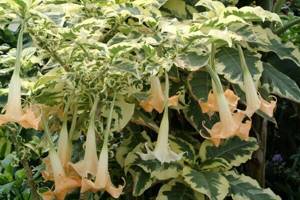
Keeping in open ground
Considering that the plant is a rather impressive tree or bush for a small garden, its planting and care in the open ground requires preliminary preparation.
The plant is planted in open ground in late May . However, experienced flower growers advise keeping the flower in a tub without burying it directly in the ground.
With this maintenance, it will be easier to transfer the tree to wintering and there will be no problems with the required conditions. This is what owners do who have Brugmansia in the Moscow region doing well.
Choosing a place
When looking for a place to plant Brugmansia in your country house, look for an area with good lighting, but protected from the wind . Receiving a lot of light, the tree gives lush flowering.
Important! On particularly hot days, the plant must be sprayed.
Soil preparation
Having prepared the hole for planting, pour a special substrate into it. It contains fertile soil enriched with humus . To add looseness and good water permeability, add peat and coarse sand.
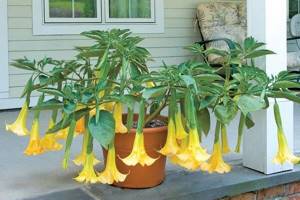
Watering
Brugmansia will easily cope with the heat if it has moist soil. This means that watering should be plentiful and regular . At low temperatures, let the soil dry out slightly.
If you keep a flower at home, do not forget about a high drainage layer. In summer, water the tree every day, but little by little, maintaining light moisture around the trunk.
Fertilizers
The schedule for feeding is as follows:
- in the spring-summer period - add liquid mineral mixtures 2 times a month;
- if the tree has bloomed, fertilize it with mixtures that contain a lot of potassium.
Trimming
The “witch’s grass” has a wide crown, so pruning is part of the mandatory care procedure . They start it in early spring.
Old branches are removed, while clearly shriveled shoots are cut to the very base, but living branches are shortened by 1/3 of their length (ready material for cuttings). After pruning, both straight and V-shaped branches should remain in the crown.
View this post on Instagram
Posted by Dekorativ bitkilərin satışı (@dekorativ__bitkiler) Sep 5, 2021 at 6:42 am PDT
Attention! The first pruning of Brugmansia is done in the second year after its first flowering.
Preparing the plant for winter
In temperate latitudes, when night temperatures drop below 5 °C, Brugmansia cannot remain in the open air. Caring owners move the tree to a warm room, reduce watering, but be sure to spray and ventilate.
Don't be alarmed if your beauty sheds all her leaves - this is a normal seasonal occurrence for her . Moreover, the tree, like our ordinary birch, for example, goes into hibernation for the winter.
Where to identify Brugmansia for the winter
A basement is suitable for winter storage of the plant. Before removing the ulrika for the winter, it should be pruned . During mild winters, you can leave the tree in the garden, but after cutting off the branches, cover it with straw and install a frame covered with several layers of agrofibre .
You need to put a film on top that will protect the shelter from moisture. To prevent the wind from tearing off the covering materials, the structure is wrapped with ropes.
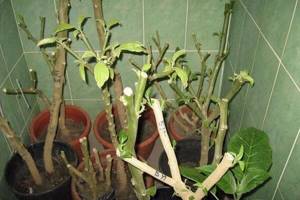
Overwintering Brugmansia on a balcony or veranda is allowed if it is possible to keep the temperature on them around 13 °C.
Tree care
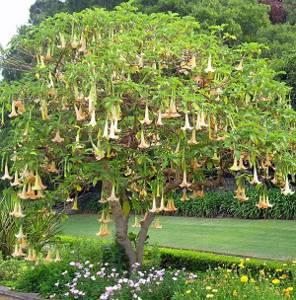
- Watering. In hot weather, when the soil in the pot (in the flowerbed) dries out, the bush should be watered abundantly. In winter, look at the conditions of maintenance: if the bush is in the house (heat + light), it needs to be watered often. If you hid it in the cellar, you also need to water it, but very carefully so that the soil does not dry out 100%.
- Spraying. Brugmansia leaves (especially young ones) love them, flowers do not, so spray either a non-flowering plant, or cover the flowers with something during the procedure. In addition, it is better to spray in the evening, when the sun no longer illuminates the bush. If you spray Brugmansia in the morning or afternoon, droplets of water remaining on the leaves can cause sunburn. In winter, if the bush is located near the battery, it is necessary to spray it.
- Feeding. Since this bush blooms very profusely, it cannot be fed without feeding (especially if it grows in a pot all the time). In summer, the bush needs to be given either a complex “mineral water” or organic matter every 7-10 days. During flowering, phosphorus and potassium should predominate in the diet. In autumn and spring, the bush is fed less frequently - about 2 times, and in winter - once a month (and even then only if it is kept warm). During the “non-flowering” seasons, the bush needs nitrogen, especially if strange yellow stripes or stains appear on the leaves.
Circumcision
Thanks to pruning, Brugmansia grows new stems, on which flowers will then appear. This procedure is necessary for the decorative appearance of the bush.
It is better to prune the bush from February to the second week of March. During this period, you need to assess the condition of the flowerpot by removing dry or diseased stems, and, if desired, also decorating its crown and cutting healthy branches into cuttings.
When pruning shrubs, remember a few rules:
- You can only touch the side branches, but not the main stem;
- Do not touch small horizontal branches growing from above, as well as Y-shaped branches - they are needed for flowering;
- It is worth working with rubber gloves.
You will see the merciless haircut of this crop here:
Preparing for winter
You need to take the plant from the street when the night temperature drops to +6 degrees.
There are several ways you can go.
- Preservation of flowering. Move the bush (by transshipment) to a warm house, where it will be constantly lit. Feed it as you do in the summer, and it will continue to bloom until January... If, of course, you are satisfied with the smell of flowers, which will fill the entire home.
- Wintering with leaves. Place the flowerpot in a cool (12-8 degrees), bright room. Feed once every 30 days.
- Deciduous wintering. Keep the flowerpot in a warm (8 to 5 degrees), dark, dry basement. The leaves of the plant will fall off. At the end of February, move the flowerpot to a warm (+12 degrees and above) veranda, where its buds will wake up and begin to grow new leaves. After this, it can be displayed/replanted in the yard.
You can listen to how a woman who has been growing this crop for a long time and with love organizes the wintering of her Brugmansia here:
https://youtube.com/watch?v=d-tMHw1jC48
Home care
There are no particular difficulties in caring for an indoor flower, except for its size.
Illumination
Care at home begins with determining a place for the flower, where there should be a lot of light . Brugmansia loves the sun and blooms only when there is a lot of it.
In winter, it sheds its leaves and does not need much light, but you will have to find a cooler place for the plant.
Temperature
Heat-loving by nature, Brugmansia feels great at 22...25 °C. With the onset of cold weather, when the temperature drops to 5 °C and below, it is better to remove the plant from the site, otherwise it will die.
When kept at home, there is no problem with high temperatures; rather, the question arises of where to find coolness for the winter . For the plant, a comfortable winter temperature is 13...16 °C.
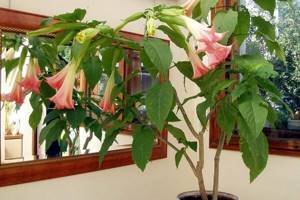
Top dressing
The flower of strength does not suffer from a lack of appetite for feeding; it loves to be constantly fed, and responds gratefully with lush flowering and a dense crown .
Since the beginning of spring, it has been fed with mineral complexes at the rate of 1 time per week.
Important! At the beginning of summer, they are transferred to feeding fertilizers for flowering plants with the same frequency of application.
Features of transplantation
The rapid growth of young plants forces owners of indoor Brugmansias to replant them several times a year .
This is done by transshipment; a new pot is taken that is slightly larger in diameter. A handful of mineral fertilizer is added along with the soil.
If you are planting a young tree in the garden, add chicken manure to the soil.
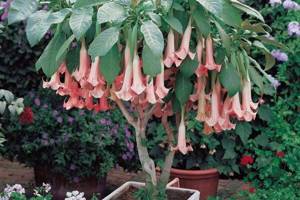
Earth mixture
For a lushly flowering plant, the soil must be nutritious so that it has enough strength for both foliage and large flowers. The optimal composition looks like this:
- 1 part each of loam and well-purified humus;
- 2 parts peat.
The soil must first be disinfected by spilling potassium permanganate or calcining it in the oven. The plant is large, therefore, and it will need a decent size pot, somewhere around 10–30 liters.
When will Brugmansia seeds germinate?
With proper planting and care, Brugmansia seeds will germinate in 10-20 days at home. But this rarely happens. Typically, in the middle zone, seedlings appear after 1.5 months. The duration of seed germination is influenced by many factors:
- freshness of planting material;
- environmental conditions (air humidity, temperature, lighting);
- quality of crop care;
- varietal characteristics.
As soon as the replacements germinate, the cover must be removed.
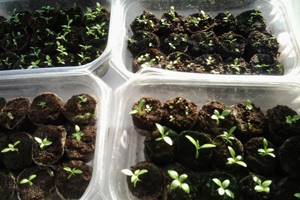
This kind of hardening will help the plant adapt to being in the garden in the summer.
Rules for keeping on the street
With the onset of summer, the flower is taken out into the fresh air (loggia, balcony, veranda). The place where you will place the tub with the tree should be well lit and inaccessible to drafts .
On the south side, you need to create such conditions so that the sun does not burn your pet all day long. Build some shade during particularly hot hours. It is better to place the flower pot on the eastern and western sides of the house .
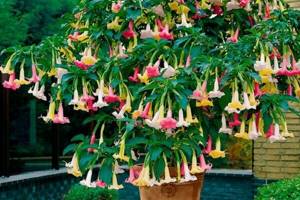
After flowering
The flowering period of Brugmansia lasts a long time, and in place of each flower a pod with seeds is formed. So that the plants do not waste energy on their formation and continue to actively bloom, it is necessary to remove the pods that appear .
When the autumn temperature begins to drop to 13...15 °C, the plant is removed from the street. If it grew in open ground, it is cut off, dug up and, planted in a pot, placed in the basement.
When kept indoors, they are returned to the windowsill, where there are no heating devices .
Planting, features of growing from seeds
Before planting Brugmansia, you need to take care of preparing a suitable soil mixture, since in its homeland the flower grows on very fertile loams, which will have to be recreated.
To do this, take an equal volume of vermicompost and clay soil and mix it with two parts of peat. After thorough mixing, pour in a weak solution of potassium permanganate for sterilization. This substrate is excellent for planting young seedlings, replanting adult plants and sowing seeds.
Reproduction of Brugmansia by seeds is quite labor-intensive and is associated with the main disadvantage - the inability of plants grown from seeds of hybrid varieties to inherit the characteristics of the shape and size of the flowers of the parent individuals.
The time from the beginning of January to the end of March is considered optimal for sowing seeds. To do this, the prepared substrate is loosened, moistened, and the seeds are planted to a depth of 1 cm, after which they are covered with film.
Shoots appear closer to 4-6 weeks, after which the film is removed and the soil is lightly moistened up to 2 times a day to prevent drying out. After four true leaves appear, the seedlings are transplanted to permanent locations.
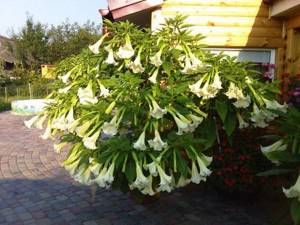
A few weeks after replanting, the first fertilizing is carried out with nitrogen fertilizer, and then fertilized monthly with universal fertilizer. The first flowers after propagation by seeds will appear after at least a year of plant life.
Brugmansia seeds are quite dense. To speed up germination, they are soaked for a day in a root formation stimulator, after scratching the surface of the seed with a knife or other sharp object to break the integrity of the hard shell.
Rules of care
Brugmansia does not tolerate frost, which is why its home is a large, stable container that can hold a lot of substrate, but in warm weather it grows well in the garden, preferring sunny places. Caring for the plant consists of observing the following rules:
- Transfer. Produced in the spring in a pot larger in size than the previous one, or in open ground when stable positive temperatures are reached. For abundant flowering, the plant needs bright light and fresh air.
- Watering. The plant is characterized by the presence of large leaves that intensively evaporate moisture and are sensitive to strong winds. A place for Brugmansia is selected with plenty of sun, but protected from strong winds. Maintaining the water regime consists of abundant watering once a day in warm weather, and in hot weather twice a day with excess water. The plant reacts to its deficiency by shedding leaves and buds.
- Trimming. Brugmansia requires this method of care all year round: branches growing below the first forks are removed, but knotty and small ones should be left, as flowers appear from them.
- Feeding. Along with replanting the plant, chicken droppings or fertilizers for indoor plants are added to the soil mixture. The crop loves organic matter, but also needs mineral fertilizing, especially phosphorus-potassium, before and during flowering.
- Wintering. When temperatures reach about 5-7°C in autumn, the plant is transplanted into a pot, heavily cutting off the roots and treating them with charcoal. In winter, the optimal temperature will be 10-15°C, but it should not be allowed to drop to 5-6°C. Failure to comply with such conditions threatens Brugmansia with death.
- Disease and pest control. Pests that often attack the plant include whiteflies, aphids, caterpillars, slugs and spider mites. The plant must be periodically examined and, if necessary, treated with pesticides. Of the diseases, gray rot most often causes harm, which, when detected, is destroyed with a fungicide.
There is an option for overwintering Brugmansia, in which it is placed in a dark room with a temperature of about 5°C, and the plant will shed all its leaves, which will be restored in the spring. Watering should be minimal, just to prevent the roots from drying out.
Growing Brugmansia in open ground is not particularly difficult. The main thing is to follow the rules of care and find a suitable room for overwintering the plant.
Caring for a tree will be a pleasant experience for any gardener, who will reward all their efforts with its picturesque view and huge fragrant flowers.
Exotic Brugmansia - planting and care in open ground
- 0.00 / 5
5
- 1 / 5
- 2 / 5
- 3 / 5
- 4 / 5
- 5 / 5
votes, 0.00 avg. rating (% score)
Reproduction of Brugmansia
Brugmansia propagates by cuttings and seeds. Both methods are successfully used by flower growers, and we will tell you about them in detail.
Cuttings
Cuttings are harvested in the spring, when the plant is pruned:
- All leaves are removed from young healthy branched branches.
- The lower cut is moistened in a growth stimulator and lowered into a container of water. The water is changed every day.
- Around the 10th day, the first roots appear, and the cutting is transferred to a small pot with soil.
- A month later, the young seedling is transplanted into a larger pot.
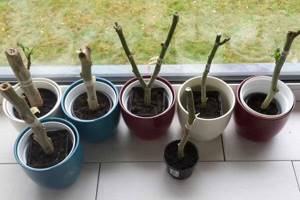
Seeds
If you decide to propagate Brugmansia by seeds, remember that it will begin to bloom only after 2–3 years.
The step-by-step germination process looks like this:
- Choose full and healthy seeds. Lightly scratch their surface (this is called scarification) for better germination.
- Pour the growth stimulator into a saucer, put the seeds in it and leave for 2 days.
- Prepare a container with soil. We plant the seeds, deepening each seed by 1 cm. We spray the planting and cover it with film.
- Place the container in a place with good lighting. Constantly ventilate and spray (2-3 times a day).
- When 4–5 leaves are formed on the sprouted shoots, we pick them into separate cups.
- From 2 months, seedlings can be transferred to a permanent place of residence and fed with nitrogen fertilizers. At the age of 4 months we switch to feeding with complex mixtures.
Important! Brugmansias grown from seeds at home rarely inherit their mother's characteristics.
How to root Brugmansia cuttings
Rooting of Brugmansia cuttings is carried out in two ways: in the substrate and in water.
Everyone chooses a convenient method for themselves. Rooting Brugmansia in the substrate will require less time resources. The lower leaves of the cut stems are torn off; if they are long, they are divided into cuttings 15-20 cm in size and placed in water or substrate for rooting.
Rooting in the substrate
Since not all Brugmansia varieties take root in water, they resort to rooting cuttings in the substrate.
Before planting a Brugmansia cutting in a pot, you need to prepare a planting pot. Place drainage (vermiculite, polystyrene foam) at the bottom of the pot, then add substrate. A depression is made in the substrate and a cutting is placed. The earth around the cutting is lightly crushed, then covered with a jar, creating greenhouse conditions. When planting in a substrate, root growth stimulants are used. Up to four pieces are inserted into pots. In a month, the plant will be ready to be transplanted to its permanent habitat.
Rooting Brugmansia cuttings in water
To root cuttings in water, use settled warm water.
To prevent stems placed in water from rotting, an activated carbon tablet is diluted in it. A little water (3-5 cm) is poured into the bottom of a jar or plastic glass and the cuttings prepared in advance are placed in a container, then transferred to a warm, well-lit place. Not only water, but also oxygen is involved in the formation of roots, so the water level should not be high. The container with the cutting is covered with polyethylene and placed in a warm, bright place. After 10-15 days, the first roots will appear.
Important! Activated carbon must be added to the water to avoid rotting of the roots.
Growing difficulties
Naturally, a plant that came to us from the shores of South America requires special treatment. Any violation of the parameters he needs can lead to diseases and negative changes in appearance .
Leaves turn yellow and fall off
The leaves of the tree are turning yellow, what should I do? The main reason for the falling and yellowing of leaves lies in the excess of nitrogen compounds in fertilizers . Change the brand of fertilizer.
Adverse climatic conditions
If you keep the tree in open ground, monitor the temperature . Do not plant it until the air warms up to 15...20 °C.
Did you see in the weather forecast that the temperature at night will drop to 8...10 °C? Move the plant indoors. Because of the cold, the leaves of the flower turn yellow and it drops them.
View this post on Instagram
Publication from Magic of Flowers (@magazin_magia_cvetov) Aug 31, 2021 at 11:46 PDT
Damage by insects and pests
The main pest that affects Brugmansia is the spider mite . To prevent its occurrence, maintain a high level of humidity and mist the plant frequently.
A tree growing in a garden is loved by slugs, caterpillars and aphids . If you find pests, do not give up, but treat the plant with fungicides 2 times a week.
Lack of nutrition
In order for your flowering tree to be beautiful and cheerful, it needs frequent feeding. Apply mineral fertilizers containing phosphorus and potassium . Alternate them with organic mixtures.
Why doesn't it bloom
Flowering does not occur for two reasons: lack of light and excess nitrogen in the soil.
Growing Brugmansia: from seeds, cuttings
For the fastest germination of seeds and good growth of young plants, it is necessary to prepare the correct soil mixture. The flower's homeland is the southern part of America, where it grows on light, not particularly nutritious soils and loam. Therefore, something similar needs to be prepared before planting.
To prepare the soil mixture you need to take:
- clay soil – 1 volume;
- vermicompost, which can be replaced with humus - 1 volume;
- peat – 2 volumes.
All ingredients must be mixed thoroughly. To disinfect the substrate, pour a light solution of potassium permanganate. Only after this can you safely sow Brugmansia seeds.
Sowing seeds
Brugmansia should be propagated by seeds from January to the end of March. Planting material should first be kept in a growth stimulator to increase germination. Epin or Kornevin are suitable for this. The prepared soil mixture is slightly moistened, loosened, the seeds are placed in holes 1 cm deep. Gaps of 3 cm are left between the holes. The container should be kept under a film on a well-lit windowsill.
On this topic:
BACK
FORWARD
1 of 3 620
At the end of winter, daylight hours are short, so Brugmansia grains must be additionally kept under an ultraviolet lamp for 2-3 hours. The first shoots appear in about a month. After this, the container is opened to allow access to fresh air.
Until the sprouts get stronger, you need to harden them. To do this, you will need to remove the greenhouse for several minutes, gradually increasing the ventilation period. If the weather is good at the end of April and at the very beginning of May, the container with Brugmansia is taken outside.
Cuttings
With this method of propagation, you need to use only long shoots of 15-25 cm. They must be annual with a bud at the top.
Planting material should be separated at the very end of May or at the beginning of June. The prepared cuttings are placed in water and kept in a mini-greenhouse until roots appear.
Planting seedlings and caring for them
On this topic:
BACK
FORWARD
1 of 1 811
Brugmansia seedlings grow slowly. They need to be replanted only when the height reaches 5-6 cm.
An important procedure for caring for a plant is picking. It should be carried out when the seedlings have 4 leaves.
They should be replanted into deeper and more spacious pots, always with a layer of drainage at the bottom. When replanting, you should not destroy the earthen ball so as not to damage the young roots. The soil for planting must be moist and nutritious.
Watering seedlings
Brugmansia has large leaf blades through which moisture evaporates, so the flower requires abundant watering in warm weather. In the cold half of the year, the plant is irrigated moderately
It is important to ensure that the soil does not dry out, but is not too wet. Accumulation of water can lead to the death of the flower
Warm water is suitable for irrigation.
Fertilizer
The first feeding of seedlings should be carried out only 2 months after germination. To do this, use fertilizers with a small amount of nitrogen compounds. Feeding is carried out once a week. When Brugmansia reaches the age of 5 months, complex preparations can be applied to ensure good growth of the flower.
Diseases
Among plant diseases, it is worth highlighting gray rot . It occurs due to increased soil moisture. Treatment consists of not watering for a week, removing rotten shoots and treating the flower with Topaz.
To prevent diseases, it is recommended to spill the tree trunk circle with a solution of slaked lime.
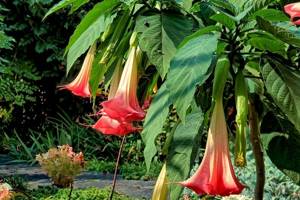
The beauty of blooming Brugmansia attracts many admiring glances. Many gardeners dream of having such a wonderful tree in their garden.
If you decide to have a “flower of power”, carefully study all the nuances of care and weigh your strengths .


